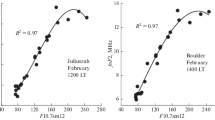Abstract—
This work is a continuation of the author’s earlier analysis of the relationship between the most often used solar-activity index, F10.7, and solar-activity indices (Ly-α, Rz and Mg II) that reflect variations of the ultraviolet radiation of the Sun, which governs the behavior of the main ionospheric layers. It is shown that the relationship between F10.7 and the three aforementioned indices are close to each other in the 22nd and 23rd activity cycles. However, they differ from those in the two previous cycles and are less statistically significant in the 24th cycle. For the same values of the Ly-α, Rz, and Mg II indices, the F10.7 values in the 24th cycle are lower than those in the two previous cycles. This explains the earlier finding that the use of the F10.7 index without correction in the analysis of foF2 and hmF2 behavior in the 24th cycle leads to positive trends, which contradicts the current ideas on the cooling and contraction of the upper atmosphere. Correction of the F10.7 with the three aforementioned indices is proposed for the calculation of ionospheric trends.


Similar content being viewed by others
REFERENCES
Balogh, A., Hudson, H.S., Petrovay, K., and von Steiger, R., Introduction to the solar cycle: Overview of causes and consequences, Space Sci. Rev., 2014, vol. 186, pp. 1–15. https://doi.org/10.1007/s11214-014-0125-8
Chen, Y., Libo, L., and Wan, W., Does the F10.7 index correctly describe solar EUV flux during the deep solar minimum of 2007–2009?, J. Geophys. Res., 2011, vol. 116, A04304. https://doi.org/10.1029/2010JA016301
Chen, Y., Libo, L., Le, H., and Wan, W., How does ionospheric TEC vary if solar EUV irradiance continuously decreases?, Earth Planets Space, 2014, vol. 66, id 52. https://doi.org/10.1186/1880-5981-66-52
Chen, Y., Libo, L., Le, H., and Wan, W., Ionospheric variations under extremely low solar EUV condition, Proc. 10th Workshop on Long-Term Changes and Trends in the Atmosphere, Hefei, 2018.
Danilov, A.D., Seasonal and diurnal variations in foF2 trends, J. Geophys. Res.: Space, 2015, vol. 120, pp. 3868–3882. https://doi.org/10.1002/2014JA020971
Danilov, A.D. and Konstantinova, A.V., Variations in foF2 trends with season and local time, Geomagn. Aeron. (Engl. Transl.), 2015, vol. 55, no. 1, pp. 51–58.
Danilov, A.D. and Konstantinova, A.V., Trends in foF2 and the 24th cycle of solar activity, Geliogeofiz. Issled., 2019, no. 23, pp. 42–49.
Danilov, A.D. and Konstantinova, A.V., Long-term variations in the parameters of the middle and upper atmosphere and ionosphere (review), Geomagn. Aeron. (Engl. Transl.), 2020a, vol. 60, no. 4, pp. 397–420.
Danilov, A.D. and Konstantinova, A.V., Trends in parameters of the F2 Layer and the 24th solar-activity cycle, Geomagn. Aeron. (Engl. Transl.), 2020b, vol. 60, no. 5, pp. 586–596.
Danilov, A.D. and Konstantinova, A.V., Further analysis of the foF2 trends to 2018–2019, Geliogeofiz. Issled., 2020c, no. 27, pp. 46–54.
Danilov, A.D. and Konstantinova, A.V., Trends in foF2 and the 24th solar activity cycle, Adv. Space Res., 2020d, vol. 65, pp. 959–965. https://doi.org/10.1016/j.asr.2019.10.038
Danilov, A.D. and Konstantinova, A.V., Trends in hmF2 and the 24th solar activity cycle, Adv. Space Res., 2020e, vol. 66, pp. 292–298.
De Haro Barbás, B.F. and Elias, A.G., Effect of the inclusion of solar cycle 24 in the calculation of foF2 long-term trend for two Japanese ionospheric stations, Pure Appl. Geophys., 2020, vol. 177, pp. 1071–1078.
De Haro Barbás, B.F., Elias, A.G., Fagre, M., and Zossi, B.F., Incidence of solar cycle 24 in nighttime foF2 long-term trends for two Japanese ionospheric stations, Stud. Geophys. Geod., 2020, vol. 64, pp. 407–418. https://doi.org/10.1007/s11200-021-0584-9
Emmert, J.T., Lean, J.L., and Picone, J.M., Record-low thermospheric density during the 2008 solar minimum, Geophys. Res. Lett., 2010, vol. 37, L12102. https://doi.org/10.1029/2010GL043671
Laštovička, J., Stability of solar correction for calculating ionospheric trends?, in Proceedings of the 9th Workshop on Long-Term Changes and Trends in the Atmosphere, Kühlungsborn, Germany, 2016.
Laštovička, J., A review of progress in trends in the mesosphere–thermosphere–ionosphere system, Proc. 10th Workshop on Long-Term Changes and Trends in the Atmosphere, Hefei, 2018.
Laštovička, J., Is the relation between ionospheric parameters and solar proxies stable?, Geophys. Res. Lett., 2019, vol. 46, no. 24, pp. 14208–14213. https://doi.org/10.1029/2019GL085033
Laštovička, J., Akmaev, R.A., Beig, G., Bremer, J., Emmert, J.T., Jacobi, C., Jarvis, M.J., Nedoluha, G., Portnyagin, Y.I., and Ulich, T., Emerging pattern of global change in the upper atmosphere and ionosphere, Ann. Geophys., 2008, vol. 26, no. 5, pp. 1255–1268.
Livingstone, W., Penn, M.J., and Svalgaard, L., Decreasing sunspot magnetic fields explain unique 10.7 cm radio flux, Astrophys. J. Lett., 2012, vol. 757, no. 1. https://doi.org/10.1088/2041-8205/757/1/L8
Solomon, S.C., Qian, L., Didkovsky, L.V., Viereck, R.A., and Woods, T.N., Causes of low thermospheric density during the 2007–2009 solar minimum, J. Geophys. Res., 2011, vol. 116, art. ID A00H07. https://doi.org/10.1029/2011JA016508
Solomon, S.C., Qian, L., and Burns, A.G., The anomalous ionosphere between solar cycles 23 and 24, J. Geophys. Res.: Space, 2013, vol. 118, pp. 6524–6535.
Author information
Authors and Affiliations
Contributions
The monthly mean values of the sunspot numbers Rz and the Ly-α and Mg II indices were taken from the site (https://lasp.colorado.edu).
Corresponding author
Additional information
Translated by A. Danilov
Rights and permissions
About this article
Cite this article
Danilov, A.D. Solar-Activity Indices in the 24th Cycle and the Behavior of the Ionospheric F2-Layer. Geomagn. Aeron. 61, 222–226 (2021). https://doi.org/10.1134/S0016793221020043
Received:
Revised:
Accepted:
Published:
Issue Date:
DOI: https://doi.org/10.1134/S0016793221020043




